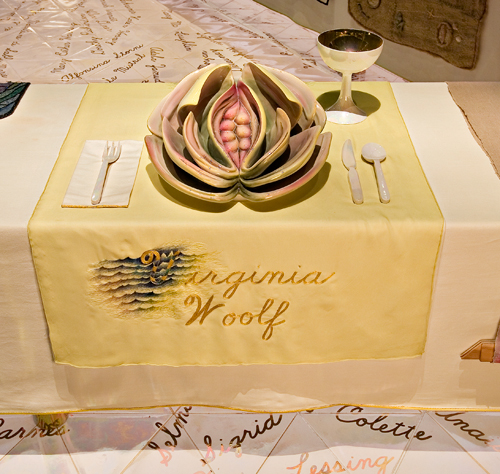The Art and Women class has taught me a great deal about art
and female artist. One day I asked my friend if she could name five female artists and
could not even name one female artist. Actually, this was me before taking this
class and now I am able to recognize more women artists. This question makes me question why is women artwork still unrecognized today. In this essay I have included Judy
Chicago, Frida Kahlo, Georgia O’Keeffe, Harriet Powers, and Shirin Neshat as
female artist whose work has been a major breakthrough in art and for women.
Judy Chicago is an author, writer, artist and one of the
pioneers of feminists Art during the 70’s. Judy Chicago was born in Chicago,
Illinois, 1939. During her teenage years she took classes at the Art Institute
of Chicago. She also went to train at the UCLA, where she obtained her M.F.A in
1964. Additionally, in the Brooklyn Museum her installation artwork, The Dinner Party (1939) is on displayed.
This installation is a triangular table
comprised of thirty-nine place settings. On the floor the name of 999 artists
are in gold and white. Chicago Dinner Party is celebrates women artist who have
been undermined by people. One that I found interesting when looking at this
piece is the shapes because each place has the shape of a vulva. The Dinner
Party is a clear representation of feminist art that challenges politics and
men.
Frida Kahlo has left a great impression and has made a great
impact on my life. Kahlo was a Mexican painter and self-portrait artists. She was influence by Realism, Symbolism, and
Realism. In 1929, she married Diego Rivera with whom she had a tumultuous
relationship. Kahlo’s artwork depicts her personal experience such as her
miscarriages and inability to conceive a baby, marriage, and the operations she
received after the bus accident she was in.
Frida Kahlo. Henry Ford Hospital (The Flying Bed). 1932
The painting Henry Ford Hospital reflects what Kahlo felt
when she was having a miscarriage. The painting depicts Kahlo connection to six objects. One of them is a male fetus, which reflects her wish to become a
mother. Another object is the female reproductive system, a snail, an orchid,
and a fractured pelvis. Another famous painting is The Broken Column depicts
Kahlo as a strong woman. It also depicts a split torso and nails covering her
face and body. A hospital sheet covers her lower body. This painting reflects
Kahlo pain in her personal life. She pains herself as being broken and in pain. A corset is what keeps her body together. Although she depicts herself being broken, she is still holding on and looks strong.
Frida Kahlo. The Broken Column. 1944
Georgia O’keeffe was born on November 15, 1887 in Sun
Prairie Wisconsin. She was a 20th century who was known for her southwestern
landscape and flower canvases. During the early 1900’s she studied at the Art
Institute of Chicago. After this she attended the Art Student League in New
York. She played an important role in
the development of Modernism. One of her most important works includes Oriental Poppies (1928). O’keeffe illustrates the abstract shape of the
flower putting an emphasis on the elements of the color, shape, and texture in what she paints. Additionally, Judy
Georgia O'Keeffe. Oriental Poppies (1928)
Judy Chicago. The Dinner Party (1979).
Harriet Powers was born on October 29, 1837 in Clarke
County, Georgia. She was born a slave and she was an African American slave and
quilt maker. She married Armstead Powers and had about nine children. Powers
may have made many quilts during the time she was alive, but as of today only
two are the ones that remain and have been preserved. The first is the Bible
Quilt (1886), and the second is the Pictorial Quilt (1898). In these two quilts
Powers uses the traditional African applique technique. Other mediums or
techniques that she uses consists of embroidered, quilted, and cotton plain
wave. Both quilts also significant Biblical stories. For instance, the
Pictorial Quilt is divided in fifteen sections. The fifteen pictorial depicts
God crucifixion and the two thieves.
Harriet Powers. Bible Quilt. 1886
Harriet Powers. Pictorial Quilt. 1898
Shirin Neshat was born in Qazvin, Iran in 1957. At the age
of seventeen she moved to the United States for educational purposes. In 1983,
she obtained a BA from the University of California at Berkeley. Her earliest
works consists of photograph, which includes Unveiling (1993), and Women of
Allah (1993-97) series. Certainly, the video that spoke to me the most was
Turbulent (1998). This video along with
Rapture (1999) and Fervor(2000) use dual video screens that emphasize on the
abstract oppositions based on gender and society. Turbulent depicts a man who
is singing with and audience on one side of the screen. On the other side of
the screen there is a woman who is signing, but with no audience. Neshat depicts in Turbulent how females are being
unrecognized. The male exerts more authority over a woman. In this video the
female is more talented, but still due to the norms and society they are not
known or taken seriously.
Shirin Neshat. Turbulent. 1998.
Shirin Neshat. Fervor. 2000.
After taking the Art and Women’s class, I can say that I can
name five women artists. Shirin Neshat, Judy Chicago, Harriet Powers, Georgia
O’Keeffe, and Frida Kahlo are female artists whose artwork has been a
breakthrough in art and for women including myself. Their artwork deserves
praise and to be more recognized by people.







































